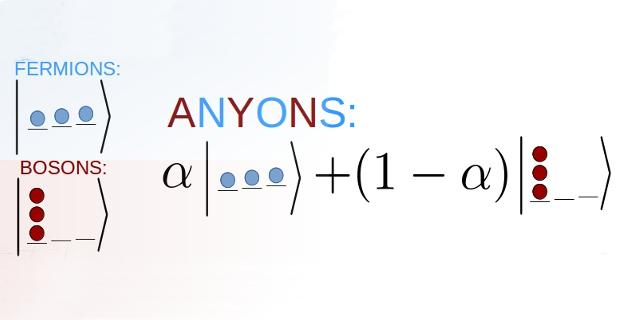Sep 23 2020
While all particles should exist either as bosons or fermions in a 3D world, researchers already know that in fewer dimensions, the presence of particles with intermediate quantum statistics, called anyons, is definitely feasible.
 When the energy levels of a quantum system are filled, fermionic particles exclude each other, whereas bosonic matter can accumulate in the lowest level. In contrast, anyons behave in an intermediate fashion. The paper shows how the anyons’ statistical parameter alpha can be detected from the angular momentum of impurity particles attached to the anyons. Image Credit: ICFO-The Institute of Photonic Sciences.
When the energy levels of a quantum system are filled, fermionic particles exclude each other, whereas bosonic matter can accumulate in the lowest level. In contrast, anyons behave in an intermediate fashion. The paper shows how the anyons’ statistical parameter alpha can be detected from the angular momentum of impurity particles attached to the anyons. Image Credit: ICFO-The Institute of Photonic Sciences.
It is strongly believed that such interesting objects exist as emerging quasiparticles in fractional quantum Hall systems, but in spite of significant efforts, experimental proof of anyons has continued to be extremely limited.
Quantum statistics is generally defined based on the behavior of the phase of the wave function, and therefore, when a pair of identical particles are exchanged, initial attempts of anyon detection were built on interferometric measurements using beamsplitter or Fabry-Perot interferometry experiments.
Until now, a number of efforts have been made to enhance the experimental proof of anyons by looking for means to analyze the FQH effect and interpret its fundamental physics in highly manageable quantum systems, like photonic quantum simulators or cold atoms.
Some studies have demonstrated that interactions between light and matter can produce and capture fractional quasiparticles in electronic systems or atomic gases and quantify, via time-of-light imaging, signatures of fractional statistics that are carried by the total angular momentum of a fractional quantum Hall system.
A New Method Towards Anyon Detection
In a new study recently published in the Physical Review Letters journal, ICFO scientists Tobias Grass, Niccolo Baldelli, and Utso Bhattacharya, under the guidance of ICREA Professor Maciej Lewenstein from ICFO, and in association with Bruno Julia-Díaz from the University of Barcelona, explained a new method towards anyon detection. This method is a critical element for increasing one’s interpretation of exotic quantum matter.
By contrast to previous detection schemes, the study penned by the team offers a new potential that does not require interferometry or particle exchange. Rather, the study’s authors recommended that the behavior of the anyons should be traced by attaching impurity particles to them.
Particularly, the average angular momentum of a single impurity has been demonstrated to take characteristic values that are potentially fractional. The total angular momentum for a system of numerous impurities must subsequently rely on the way these effective single-impurity levels are filled.
Deducing the Fractional Statistical Parameter of Anyons
Remarkably, the value achieved by the study’s authors does not match either with the filling of a Fermi sea or with the condensation of a bosonic mode. Rather, the impurity angular momentum interpolates between these two limiting cases, and from this interpolation, the fractional statistical parameter of the anyons can be directly deduced.
The researchers’ detection scheme simply needs density measurements and might be relevant to Abelian quantum Hall phases in electronic materials and also in atomic or photonic quantum simulators.
The study’s authors also discussed potential generalizations towards non-Abelian anyons. Given that the impurities achieve a non-interacting gas of anyons, the researchers’ work also offers the possibility of investigating the complex thermodynamics of anyonic systems.
Journal Reference:
Graß, T., et al. (2020) Fractional Angular Momentum and Anyon Statistics of Impurities in Laughlin Liquids. Physical Review Letters. doi.org/10.1103/PhysRevLett.125.136801.